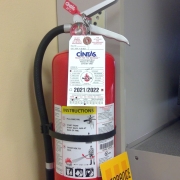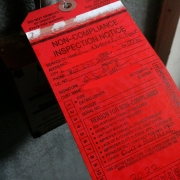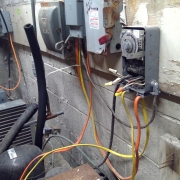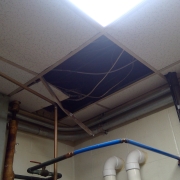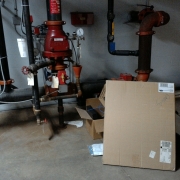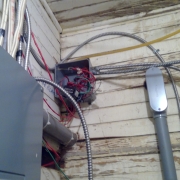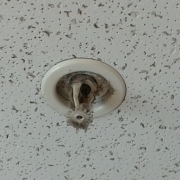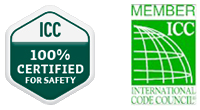Commercial, Industrial, & Multi-Family (3+ Units)
Fire & Life Safety Inpections
What is a “Fire Safety Permit”?
The CKCOG Property, Fire Safety and Building Maintenance Code (or CMC – CKCOG Maintenance Code), Chapter 7, is based on the Fire and Life Safety requirements of the International Building Code (IBC), International Electrical Code (IEC), International Existing Building Code (IEBC), International Fire Code (IFC), International Mechanical Code (IMC), International Property Maintenance Code (IPMC), International Plumbing Code (IPC), and the International Residential Code (IRC). These codes set the conditions and standards for fire and life safety relating to structures and exterior premises, including the fire safety facilities and fire protection equipment to be provided.
A Fire Safety Permit is part of a program that includes inspections to ensure these standards are maintained. The Fire Safety Permit itself also provides important information to occupants, fire fighters and police as it clearly shows the Occupancy Limits, the Construction Type and Use of the structure and provides a Emergency Contacts.
Preparing for a Fire Inspection:
Outside—
- Make sure the structure address is clearly visible from the street—4” minimum numbers
- Maintain a 36” clearance around all fire department features—sprinkler control valves, fire hydrants and fire department connections
- Fire Equipment and utility rooms are clearly identified—2” minimum letters
- Are all exterior doors free of obstructions—including vegetation
Inside—
- Are all exit doors easily open-able—not locked or chained
- Keep exit doors and corridors clear of storage and clutter
- Required or labeled “Fire Doors” must self-close and self-latch if applicable, Fire Doors may not be propped open
- Maintain combustible materials at least 36” from heat producing appliances and electrical panels
- Maintain all storage 24” below ceilings (18” if sprinklers are present)
- All flammable liquids stored in approved containers or cabinets
Administration—
- Is emergency contact information clearly posted?
- Is the building Safety Plan readily available?
- Are Evacuation and Egress routes displayed in all required locations and up to date?
- Are the maintenance records and testing results for all fire protection systems – including emergency lighting & signage, automatic fire alarms, manual fire alarms, sprinkler systems, fire extinguishers and automatic fire extinguishing systems up to date and available for review?
Anthony Township (Montour County)
Duboistown Borough
Toggle Content goes here
McEwensville Borough
Shamokin Dam Borough
Toggle Content goes here
These are the most commonly found violations and a more extensive list can be found here: “FIRE SAFETY pre inspection checklist”.
If you have questions about a specific situation, please call the Central Keystone COG at 1-877-457-9401 or 570-522-1326.
We know that you, as the property owner, care about the level of safety in your building and on the premises, and we strongly encourage you to accompany the Fire Code inspector during this inspection. Once on site, the Fire Inspectors will check your building’s exits, emergency lighting, exit signs, components of fire-resistive separation, access roadways and fire lanes, and testing and maintenance records of fire-safety systems. They will also make sure there is an emergency evacuation plan in place. The Fire Inspector will determine the Life Safety Value (LSV) of the structure, this will determine how often your structure will need to be inspected.
If the inspectors find any conditions are not in compliance with the adopted Fire Code, they will notify you and, if the conditions cannot be corrected on the spot, will issue an Inspection Report detailing the issue and giving a time frame for correction.
National statistics also show that fires occurring outside of “normal business hours” caused, on average, slightly more than double the property damage as those fires occurring during normal hours of occupancy. This finding underscores the importance of not only installing, but also maintaining automatic detection and suppression equipment to protect property.
While there are agencies, state, federal and private, that may look at many different aspects (fire related) of a building or business, there is no entity that performs ANY of these reviews or inspections on behalf of the municipality. Although Pennsylvania has adopted the International Building Code (IBC), which references the International Fire Code (IFC) extensively, the Commonwealth did not adopt the full IFC for the state. This leaves municipalities with the responsibility of enacting and enforcing ordinances to ensure continued compliance with the IBC and the safety of their structures and residents.
A Fire Safety Permit program ensures that these items are inspected on a regular basis and educates the property owner or operator on the actions and procedures required and necessity to maintain a high level of safety for employees, customers, and first responders. It does not mandate that older buildings install equipment and features to be brought up to current codes, but rather reviews the same based on the requirements at the time of construction or most recent modification to any building.
Benefits:
- A safer working/living environment for employees/residents.
- A safer building for unfamiliar occupants (visitors, shoppers, clients, etc.).
- Business and job security. Up to 80 percent of all small businesses that experience a large fire never reopen; this not only affects the building/business owner, but also results in the loss of jobs. Of the businesses that do reopen, many lose much of their customer base due to prolonged absence of production or service.
- A better-maintained building for improved resale value. It is commonplace for buyers to hire a company to inspect the building prior to purchase to identify potential hidden costs related to fire and life safety.
- A possible reduction in insurance premiums. Some items may be required by both the fire department and your insurance carrier, such as annual fire-sprinkler and fire-alarm inspections verifying proper system maintenance. Many insurance carriers give businesses premium reductions for properly installed and maintained fire-protection systems.

